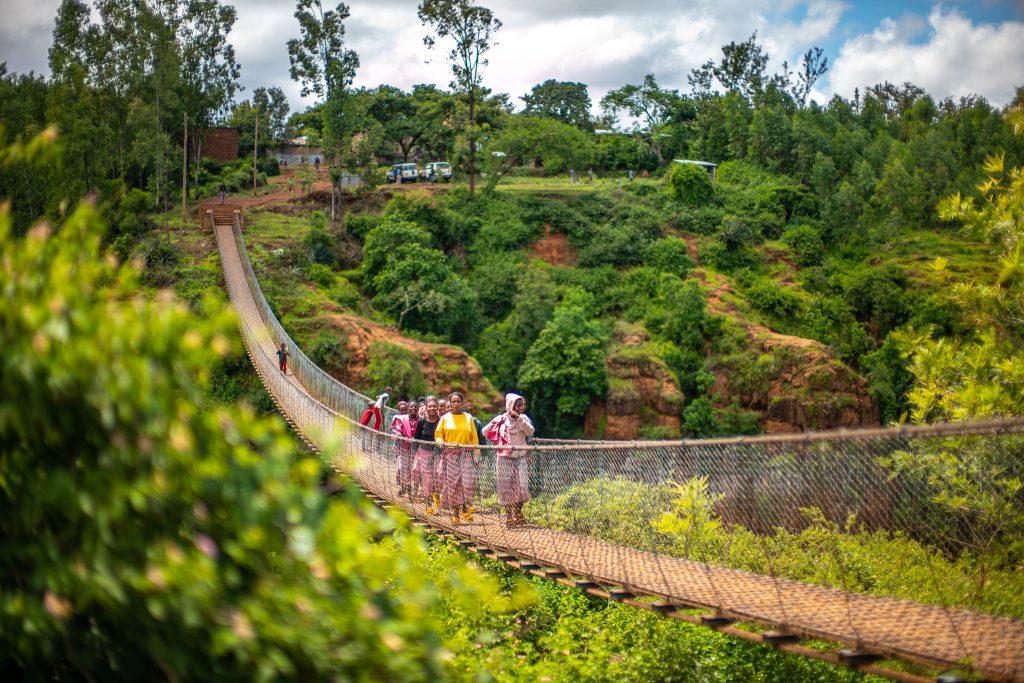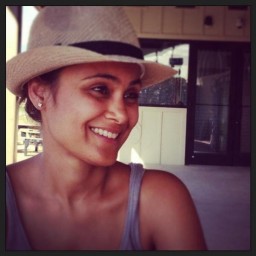
(Image courtesy of Bridges to Prosperity/Robb Hohmann)
One billion people around the world lack basic transportation access, which means they live more than two kilometers away from a usable road, as measured by the Rural Access Index. So, how do they get to a “usable” road?
Children end up taking dangerous routes to school — or don’t go to school at all — mothers are unable to reach clinics during pregnancy, and it’s hard for farmers to get to markets to earn their daily wage.
“When you look at why people cross bridges, the number one reason is critical access — to schools, hospitals, markets,” said Nivi Sharma, CEO of Bridges to Prosperity, a nonprofit organization that builds footbridges in isolated communities across the world. “Social interaction comes second.”
Yet, identifying where to build a bridge remains a major challenge. Particularly in Africa, where it is estimated that over 60 percent of rivers and waterways are unmapped, according to Bridges to Prosperity. “It was kind of shocking,” Sharma said. “Why aren’t there blue lines on the map where we know our bridge sites are?”
To solve for this, Bridges to Prosperity teamed up with the data product and services builders at Better Planet Labs to build WaterNet, an artificial intelligence (AI) model designed to map missing waterways using publicly available satellite imagery and elevation data.
“So much of our mapping efforts go into urban environments, so not only waterways, but so many other aspects of rural communities just don't live on maps,” Sharma said. “A trash can in Oklahoma has more pixels on Google Street View than some entire communities in rural Africa. There is a serious data equity problem here.”
This lack of representation has cascading effects. If a community isn’t on the map, there is no chance to allocate infrastructure or aid to it.
“You can’t build bridges if you don’t know where the rivers are,” said Cameron Kruse, director of digital technology for Bridges to Prosperity. “You can’t prioritize communities that aren’t visible.”
The WaterNet model already tripled the number of known mapped rivers globally, adding more than 124 million kilometers of previously unseen rivers and streams.
“We used low-resolution data from the European Space Agency and digital elevation models to train the model on well-mapped regions, and then applied it to unmapped areas,” Kruse said. “The AI picked up the signal of what a waterway looks like based on elevation and imagery.”
WaterNet and its data are publicly available and open-source for other organizations and governments to use, and mapping rivers is only the first step. Bridges to Prosperity uses WaterNet alongside another tool it built, Fika Map, which models travel times with and without a bridge to assess how long it takes someone to walk to a school or clinic.
“If you live in a rural community, Google Maps does not have the information to show you the real path,” Sharma said. “Fika can show you how long it really takes.”
This kind of data empowers governments to make smarter infrastructure investments. “We want to take the bias out of decision-making,” Sharma said. “If we can tell you where the barriers are, what the cost is, and what the impact will be, you can make informed, impactful choices instead of political ones.”
While WaterNet was designed with rural bridges in mind, its potential is much broader. “There’s a lot of excitement,” Kruse said. “A friend in elephant conservation told us this could be transformational. Elephants always know where the water is, but now, maybe we can too.”
Unlike high-powered AI language models, WaterNet runs on a lightweight architecture. This makes it affordable, energy-efficient and deployable at scale. “In the grand scheme of things, it wasn’t expensive to build,” Kruse said. “And its energy usage is a fraction of what newer transformer models consume.”
Despite the enthusiasm, both Sharma and Kruse are conscious of the limitations of the technology. “People think AI knows everything,” Sharma said. “But if you don’t train it right, it can exclude entire populations.”
Kruse agreed: “Always keep a human in the loop. Especially when it comes to decisions that affect people’s lives. AI is a support system, not a substitute for judgment.”
WaterNet already made a significant impact, but Sharma and Kruse see it as the beginning of a broader movement to change how the world views rural infrastructure and the people who rely on it.
“We approached this from the perspective of climate resilience,” Kruse said. “As weather patterns change, rivers become unpredictable. The communities most affected are often the least visible. That has to change.”
As weather patterns become more erratic, these communities need better tools to adapt.
“My hope is that WaterNet doesn’t sit in some academic corner of the internet,” Sharma said. “But that it really does change the mainstream maps and how we think about rural communities, where they're going, how they're getting there, and what's getting in their way.”

Abha Malpani Naismith is a writer and communications professional who works towards helping businesses grow in Dubai. She is a strong believer in the triple bottom line and keen to make a difference. She is also a new mum, trying to work out a balance between thriving at work and being a mum. In her endeavor to do that, she founded the Working Mums Club, a newsletter for mums who want to build better careers and be better mums.














